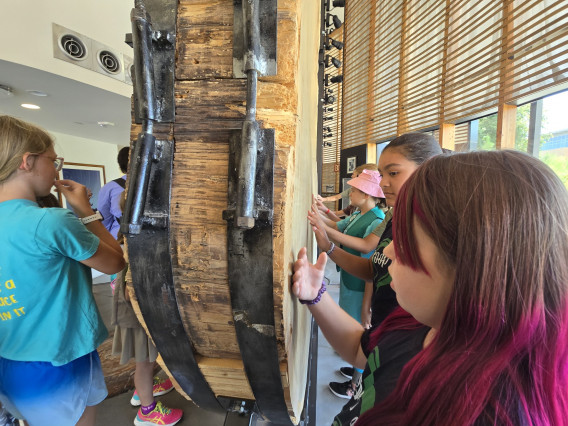Ace Hardware brings together Girl Scouts and LTRR Outreach Program
It seems unlikely that a random conversation in Ace Hardware can lead to a new collaboration between the Girl Scouts and the Laboratory of Tree-Ring Research (LTRR) . But that’s exactly what happened when Alyssa Kervran, Pillar Program Specialist for Girls Scouts met Dr. Pamela Pelletier, Community Outreach, LTRR.
Dr. Pelletier was picking up some screws for an exhibit when she saw Kervan in the checkout line wearing her Girl Scout leggings. Since Dr. Pelletier’s daughter had been involved in Girl Scouts as a child, she struck up a conversation. It turned out, Kervan was looking to increase local community partnerships and build connections at the University of Arizona, so was happy to learn about the LTRR and potential opportunities for the Girl Scouts.
Kervran said: “After meeting Dr. Pamela Pelletier and learning about the resources the tree-ring lab has to offer regarding STEM education for various grade levels, I knew it would be a wonderful opportunity for our Girl Scouts to learn more analytical skills from leading women in the field. Our middle and high school-aged Girl Scouts were empowered to delve into hands-on research projects, specifically tailored around their badge work by the staff at the lab.”
The two devised a plan to build a pilot program focused on creating a “Dendro-specific” Journey. Girl Scout Journeys are multi-session activities that help Girl Scouts explore their interests, develop leadership skills, and make a difference in their communities. Journeys include a service-learning project and are structured in three steps:
-
Discover: Girls explore their community and develop new skills through badge work
-
Connect: Girls connect their interests to community needs
-
Take Action: Girls make an impact in their communities through a service-learning project
Creating Girl Scout programming centered on dendrochronology offers an engaging, hands-on approach to immerse girls in STEM by connecting them directly with the environment. By studying tree rings, girls can learn how to track historical climate patterns, sparking interest in both biology and environmental science. This pilot program fosters critical thinking and problem-solving skills as participants analyze how climate change affects ecosystems over time. Additionally, it empowers girls to become advocates for climate action by understanding the science behind environmental shifts and their impact on future generations.
Nineteen girls arrived at the LTRR early one Saturday in September, excited to be on this adventure. After gaining some basic knowledge in tree-ring science, the girls jumped right into analysis of their tree-ring samples. Luna R and Lilly C were surprised about how much scientists can learn about the earth just from a small piece of a tree.
After the tree-ring analysis session, the Girl Scouts received a short presentation by PhD candidate Jingshu Wei on “Understanding Carbon in Forests: From Photosynthesis to Tree Rings”. This was a great opportunity for Wei to practice his science communication skills with a younger audience.
Wei said: “Every wood sample we collect had its own ‘childhood,’ just like our Girl Scouts are experiencing. Wide rings reflect times of joy, while narrow rings or scars show the periods of stress they’ve endured, much like the challenges we face in life”. Emma H said she really enjoyed learning about the carbon flux tower and the data Wei work within his studies.
Wei said: “Since joining LTRR as a PhD student in 2022, I’ve come to appreciate one of the lab’s missions: connecting with communities and the public to share our research, just like Pamela does with her amazing work leading Girl Scouts activities. LTRR is a wonderful place where tree enthusiasts can learn together. I hope that the girls, too, can be inspired by the resilience of trees as they explore the beautiful variations in ring widths across the cookies. One of the most memorable moments for me is watching the girls lift up their favorite cookies overhead and share what they had learned. It’s a powerful reminder of how trees connect us to the broader nature’s resilience."
After touring the labs and the archive, the Girl Scouts had a much-needed snack break.
Anabelle B. and Maya D said their favorite part of the visit was seeing the equipment at the Lab.
Collaborations like these between the Girl Scouts and the LTRR benefit young learners by building confidence and persistence as they take on real-world challenges and collaborate with friends, inspiring them to dream big no matter what path they choose.
Kervran said: “This opportunity has welcomed opportunities of growth and innovation for our Girl Scouts, as they have been able to take away this knowledge and apply it to further scientific experiments in their Girl Scout Journey, while having a better understanding of the intricacy of nature around them.”
“From the leaders’ perspective, we are so grateful for this opportunity, as being able to fully immerse oneself to this degree allows these future leaders to open their world to even more pathways that lie ahead of them” said Kervran.
In Spring 2025, more Girl Scouts will have the opportunity to experience the LTRR , expanding our reach and impact. With additional funding, we plan to offer field-based experiential learning, enriching the hands-on experience. Over the next year, we will refine our pilot program lesson plans based on assessments to ensure their effectiveness.




